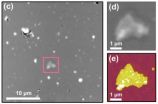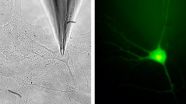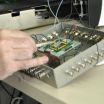(Press-News.org)
VIDEO:
Wireless. For most, the word conjures images quaint coffee shops or busy airport lobbies -- places where people drop in to check on business or check in with other people.
But...
Click here for more information.
BEAUMONT – Wireless. For most, the word conjures images quaint coffee shops or busy airport lobbies – places where people drop in to check on business or check in with other people.
But increasingly "wireless" is showing up on the farm to help produce better crops, net more money for growers and land a superior product in stores for consumers, according to experts.
Wireless agriculture is yielding benefits in rice and cotton studies by Texas AgriLife Research scientists, for example.
"We're working on a system that uses wireless sensing in rice production," said Dr. Lee Tarpley, AgriLife Research plant physiologist in Beaumont. "We'd like to be able to continuously monitor field conditions such as temperature and soil moisture, and using sensors allows us to do that. We can put them in the field and collect the data from them inside on our computer.
"We can't do that using the more typical wired sensing network because the cost of running the cables out to the field would be too expensive," he added.
Because wireless sensing networks are becoming commercially available, Tarpley said, his studies that monitor conditions such as soil moisture will eventually help farmers know how to use such a network to make crop management decisions.
While Tarpley's research focuses on wireless monitoring during the growing season, another system has been developed for use during cotton harvest time, according to Dr. Alex Thomasson, AgriLife Research agricultural engineer.
Thomasson and two graduate students devised a wireless system that can pinpoint the location on the farm where each module of cotton grew. That's important, he said, because a farmer can use the information to figure out why fiber quality differed on various acres.
"Cotton is taken to a gin to be baled. A sample from each bale is sent to a classing office to be measured for fiber quality," Thomasson explained. "The fiber quality results for each bale – along with the module number from which the bale came -- are sent back to the gin and to the farmer for use in marketing the cotton and determining its price.
"We wanted to take that data and map it back to the field the cotton was grown in," Thomasson said. "That enabled us to look at areas of a given field where cotton of different quality comes from. The ultimate goal was to produce profit maps that show how much money is being made or lost on each portion of a field."
His team's research, published in the journal Computers and Electronics in Agriculture, used wireless devices on the harvester, boll buggy and module builder to achieve 100 percent accuracy in tracking cotton to the place in a field where it grew. They call it the Wireless Module Tracking System.
AUDIO:
Wireless. For most, the word conjures images quaint coffee shops or busy airport lobbies -- places where people drop in to check on business or check in with other people.
But...
Click here for more information.
"When a farmer knows the input costs across the field, from things such as fertilizer, then the data from the Wireless Module Tracking System can help determine the profitability of each portion of the field," he said. "It can also be used to determine the reason that a part of the field had poorer fiber quality, which caused them to lose money. Then they may decide to manage that part of the field differently to make more money next year."
The system uses a global positioning system on the harvester to keep track of where the cotton in every module was harvested. As the cotton is transferred from harvester to boll buggy to module building, an identification number is sent wirelessly. That information is eventually compiled with the bale sample data from the classing office which enables a producer to backtrack to where in the field each bale was grown.
"The system can track harvester A and its harvested basket No. 276, for example, all the way to the module and the subsystem on the module building will then send a wireless message with that basket number and the module number back to the harvester's subsystem," Thomasson said. "The overall system also can handle multiple harvesters in a field, even when they dump into a common module builder."
He said the automated system also uses radio frequency identification – similar to the plastic tags on retail items that cause an alarm if not removed before exiting a store. This device automatically identifies which vehicle is dumping cotton so the busy farmer does not have to stop to input data about the harvester.
"Whereas most U.S. cotton used to be sold to domestic textile mills, most of it now is exported to Asian markets where fiber quality presents a bigger issue than ever before and where cotton competes with polyester," Thomasson said. "Polyester fibers are exactly the same because they are factory made. In cotton, there is a lot of variability. So for cotton to compete well with polyester, the fiber has to be good quality. Asian buyers want it all to be uniform."
For consumers, good quality fibers ultimately lead to a better product, he said.
Thomasson said the Wireless Module Tracking System is not yet commercially available but could be adapted by cotton harvest equipment manufacturers either as a built-in option on new models or as an add-on for existing models.
Tarpley and Thomasson agreed that wireless technology could be tapped for these and additional farming activities to help make management decisions that lead to better prices to the grower and better products for consumers.
INFORMATION:
Looking for wireless? Try a local farm
2010-11-11
ELSE PRESS RELEASES FROM THIS DATE:
AFM positioning: Shining light on a needle in a haystack
2010-11-11
The researchers characterize their new technique as a neat solution to the "needle in a haystack" problem of nanoscale microscopy, but it's more like the difference between finding the coffee table in a darkened room either by walking around until you fall over it, or using a flashlight. In a new paper,* a group from JILA—a joint venture of the National Institute of Standards and Technology (NIST) and the University of Colorado—finds tiny assemblies of biomolecules for subsequent detailed imaging by combining precision laser optics with atomic force microscopy.
The ...
Synapses recycle proteins for the release of neurotransmitters
2010-11-11
Neurons communicate via chemical transmitters which they store in the bubble-like synaptic vesicles and release as required. To be able to react reliably to stimulation, neurons must have a certain number of "acutely releasable" vesicles. With the help of a new method, neuroscientists at the Max Planck Institute of Experimental Medicine in Göttingen have now discovered that neurons systematically recycle the protein components necessary for transmitter release and in this way guarantee the reliability of signal transmission in the brain. If this process is disrupted, the ...
Portrait of gambling behavior in Quebec
2010-11-11
Montreal, November 10, 2010 – The initial findings of a survey on the prevalence of gambling in Quebec have been released. The study also deals with behavior problems associated with gambling. The study reveals that nearly 70 percent of Quebec adults report having bet or spent money on gambling during the previous 12 months. It also found Quebecers spend an average of $483 annually on gambling activities.
This survey was conducted between June and September 2009 throughout the province among 11,888 non-institutionalized adults over the age of 18. It constitutes the first ...
Army-funded technology detects bacteria in water
2010-11-11
November 10, 2010 -- To keep soldiers in the battlefield healthy, the U.S. Army is exploring new ways to detect harmful bacteria in water.
Current techniques for analyzing water in the field can take as long as 24 hours to complete, according to Bart Lipkens of Western New England College in Springfield, Massachusetts and his colleagues at Physical Sciences in Andover, Ma.
They are working on an alternative technology that uses sound waves to accelerate the process.
"The goal of our project is to speed up the detection of bacteria in water supplies," said Lipkens. ...
Evolutionary bestseller in image processing
2010-11-11
The eye is not just a lens that takes pictures and converts them into electrical signals. As with all vertebrates, nerve cells in the human eye separate an image into different image channels once it has been projected onto the retina. This pre-sorted information is then transmitted to the brain as parallel image sequences. Scientists from the Max Planck Institute of Neurobiology in Martinsried have now discovered that fruit flies process optical information in a similar way. The evidence suggests that this type of wiring is an effective energy-saving mechanism and is therefore ...
Out-sniffing bomb-sniffing dogs
2010-11-11
Dogs have long been called man's best bomb detector –– until now.
A Tel Aviv University scientist leads a research team that has developed a powerful electronic sensor to detect multiple kinds of explosives –– including those used in the recent Yemeni bomb threat. Based on nanotechnology advances, the new sensor is small, portable, and is more sensitive and reliable at detecting explosives than any sniffer dog, says its lead researcher Prof. Fernando Patolsky of Tel Aviv University's Raymond and Beverly Sackler School of Chemistry.
With scientific findings on it published ...
GM, Chrysler bankruptcies created troubling legacy, legal scholars say
2010-11-11
CHAMPAIGN, Ill. — The Chrysler and General Motors bankruptcy reorganizations represented a sea change in corporate restructuring, one that could portend the end of our current system of bankruptcy reorganization, according to a published article by two University of Illinois experts in bankruptcy law.
Law professors Charles J. Tabb and Ralph Brubaker argue that the legal principles applied in the GM and Chrysler bankruptcies – two of the largest in U.S. history at $83.5 and $39.9 billion, respectively – were misguided, and ultimately have undermined the distributional ...
'Toxic toy crisis' requires fresh solutions
2010-11-11
Manufacturer recalls of toys, promotional drinking glasses, and other children's products constitute an ongoing "toxic toys crisis" that requires banning potentially harmful ingredients in these products and other changes in policy and practices. That's the conclusion of a new analysis in ACS' Environmental Science & Technology, a semi-monthly journal.
Monica Becker, Sally Edwards and Rachel Massey note that in June the United States government recalled 12 million promotional drinking glasses sold at a fast-food restaurant chain because the painted coating contained ...
Seeing the invisible: New CSI tool visualizes bloodstains and other substances
2010-11-11
Snap an image of friends in front of a window curtain and the camera captures the people - and invisible blood stains splattered on the curtain during a murder. Sound unlikely? Chemists from the University of South Carolina are reporting development of a camera with that ability to see the invisible, and more. Called multimode imaging in the thermal infrared, the new technology could find uses in crime scene investigations and elsewhere, they say in a series of three reports in ACS' Analytical Chemistry, a semi-monthly journal.
Michael Myrick, Stephen Morgan and their ...
DNA repair protein caught in act of molecular theft
2010-11-11
Scientists have observed, for the first time, an intermediate stage in the chemical process that repairs DNA methylation damage and regulates many important biological functions that impact health conditions such as obesity, cancer and diabetes.
The observations focused on the bacterial DNA repair protein AlkB, but the results also apply to several proteins in the same family that play key regulatory roles in humans. Armed with these results, researchers may one day develop methods for blocking the protein's efforts to perform the biologically important demethylation ...






